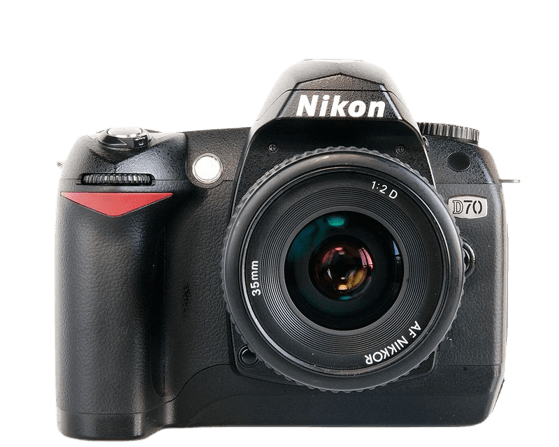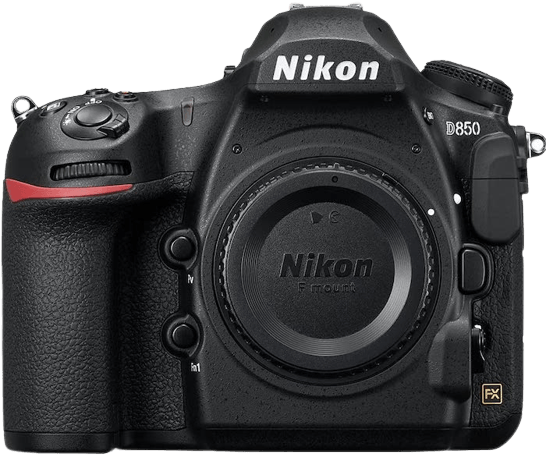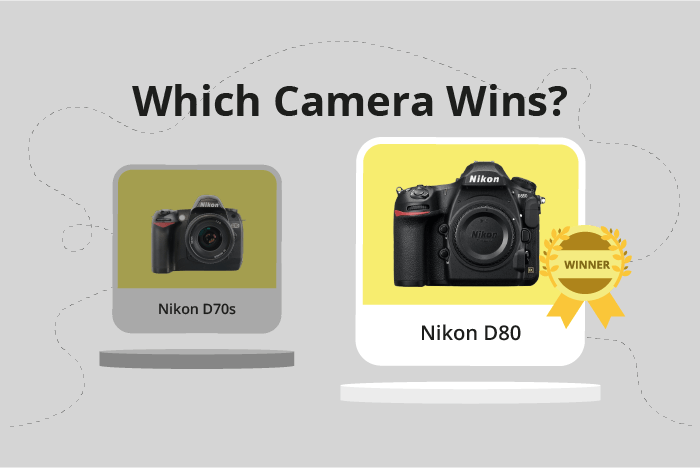Nikon D70s vs D80 Comparison
Nikon D70s

Nikon D80

The Nikon D80 outperforms the Nikon D70s with a score of 34/100 compared to 29/100. Both cameras are DSLR models, announced in 2006 and 2005, respectively. They share similarities in their launch prices, with the D80 priced at $730 and the D70s at $700.
The D80 is superior in terms of size and weight, measuring 132 x 103 x 77mm and weighing 668g, making it more compact and lighter than the D70s, which measures 140 x 111 x 78mm and weighs 679g. This advantage makes the D80 easier to handle and carry around.
On the other hand, the D70s doesn’t offer any significant advantages over the D80. The slight difference in launch prices is negligible, considering the improvements in the D80.
Taking these factors into account, it’s clear that the Nikon D80 is a better choice for photographers looking for a compact and lightweight DSLR camera, while the Nikon D70s doesn’t provide any notable benefits over its counterpart.
Nikon D70s vs D80 Overview and Optics
The Nikon D80 outshines the Nikon D70s in the optics department, scoring 39 out of 100 points, compared to the D70s’ score of 35. Both cameras share some common specifications, such as the same shooting speed of 3 frames per second, a CCD sensor type, Nikon Image processing engine, APS-C sensor size, Nikon F DX lens mount, and the absence of image stabilization.
The D80’s superiority in optics is primarily due to its higher megapixel count of 10, compared to the D70s’ 6.1 megapixels. This difference allows the D80 to capture more detailed images, resulting in better quality photos. Additionally, the D80 has a higher DXOMARK score for its sensor at 61, while the D70s only scores 50. This higher score shows that the D80’s sensor performs better in terms of color depth, dynamic range, and low-light performance.
The D70s, on the other hand, does not have any specific advantages in optics over the D80. Both cameras have the same shooting speed, sensor type, processor, sensor size, lens mount, and lack of image stabilization. The D70s only falls behind the D80 in terms of megapixels and sensor performance.
Taking into account the differences in optics, the Nikon D80 is the clear winner over the Nikon D70s. Its higher megapixel count and better sensor performance contribute to its superior image quality. While the D70s does not offer any advantages in this area, it does share some common specifications with the D80. Ultimately, photographers looking for better optics should opt for the Nikon D80.
Nikon D70s vs D80 Video Performance
When comparing the Nikon D70s and the Nikon D80, it is important to note that neither camera possesses video capabilities. Therefore, no distinction exists between the two models in terms of video functionality. Both cameras have a video score of zero due to the absence of this feature.
Nikon D70s vs D80 Features and Benefits
The Nikon D80 wins in the features category with a score of 17/100, while the Nikon D70s scores 10/100. Both cameras share some specifications, such as the absence of a touchscreen, flip screen, GPS, and Bluetooth. They both have WIFI connectivity, which is useful for sharing images quickly and efficiently.
The Nikon D80 surpasses the D70s in screen size and resolution. Its 2.5-inch screen provides more comfortable image viewing and menu navigation compared to the 2-inch screen on the D70s. Furthermore, the D80’s screen resolution of 230,000 dots delivers a sharper and more detailed display than the D70s’ 130,000 dots. These advantages enhance the overall user experience.
On the other hand, the Nikon D70s does not offer any better features than the D80. Both cameras lack in certain areas, but the D80 still manages to outperform the D70s in terms of screen quality and resolution.
Taking all these points into account, the Nikon D80 is the clear winner in this comparison. Its superior screen size and resolution provide a better user experience, while still sharing common features with the D70s, such as WIFI connectivity. The Nikon D70s, while not offering any advantages over the D80, remains a decent option for those who prioritize WIFI in their camera choice. However, the D80’s improved display makes it the preferred choice for those who value a better screen for image viewing and menu navigation.
Nikon D70s vs D80 Storage and Battery
The Nikon D80 triumphs over the Nikon D70s in the storage and battery category with a score of 53/100, compared to the D70s’s 43/100. Both cameras possess a single memory card slot, but the D80 is compatible with SD and SDHC cards, while the D70s only accepts Compact Flash (Type I or II) cards. This difference in memory card compatibility gives the D80 an advantage, as SD and SDHC cards are more common and affordable than Compact Flash cards.
The D80 also boasts an impressive battery life of 2700 shots, significantly outperforming the D70s’s 950 shots. The D80 uses an EN-EL3e battery, while the D70s relies on an EN-EL3a battery. Neither camera supports USB charging.
Although the D70s falls short in both memory card compatibility and battery life, it still maintains a respectable performance in these categories. Users who prefer Compact Flash cards may find the D70s more suitable for their needs.
In the storage and battery comparison, the Nikon D80 emerges as the superior choice due to its compatibility with more common memory cards and longer battery life. However, the Nikon D70s remains a viable option for those with a preference for Compact Flash cards.
Nikon D70s vs D80 – Our Verdict
Are you still undecided about which camera is right for you? Have a look at these popular comparisons that feature the Nikon D70s or the Nikon D80:

